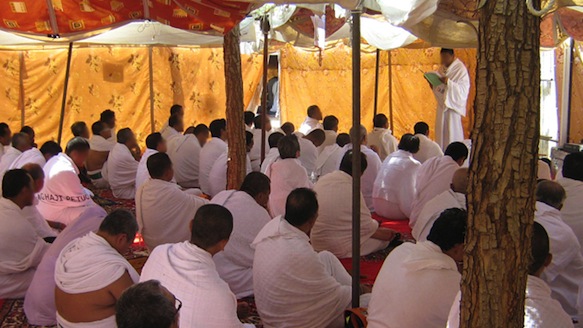A Simple Cube
While performing tawaf, pilgrims fixate their sights on the Ka’bah. But the Ka’bah is just a simple and unembellished cube, as its name implies. It is devoid of any worldly sophistication and adornment architecture-wise. Such is the case because in the kingdom of spirit these carry no weight whatsoever, especially if they are employed for some ungodly aims. Generally, on his spiritual journey man needs to partake of matter solely what is necessary and what constitute a means. More than that is bound to hinder and hold back. Benchmarking in the two realms is different and dissimilar criteria apply.
Under no circumstances should ends be converted into means and means into ends. Such is the sophistication of spirit that there is nothing in the material world that is genuinely similar to it and can be resorted to for the close analogy purposes. The best way, therefore, is to turn away from the failings of matter and stick to the innate human predispositions towards simplicity, purity, wholesomeness, equilibrium and harmony. When adequately employed, these are closer to the world of spirit than to the world of matter.
This strategy is used with regard to the structural appearance of the Ka’bah. The building is so simple, yet so complex and refined in terms of message. It represents, “houses” and radiates divinity that overcomes the people. The same holds true as regards every symbol, rite, or sign of Allah. People can sense their extraordinary quality and appeal, but cannot put what they feel into words. They merely know that they cannot get bored with, nor satiated by, the profusion of spirit.
Like the First Time
For instance, a person reads a verse or a short chapter from the Qur’an thousands of times, but every time it feels different and is like the first time – for indeed the treasures of God are inexhaustible. Another person may pronounce “All praise is due to Allah, the Lord of the Worlds” (al-Fatihah, 1:2) as a verse from the Qur’an, in which case he will feel the power – and beauty – of God’s holy Words, consciously or otherwise. However, if the same person pronounces the same formula (All praise is due to Allah, the Lord of the Worlds), albeit not intending it as God’s Words but rather as his own construction as part of his daily conversations, he will feel almost nothing about it.
The reason for this is straightforward: the former is infused with the life-force of the highest levels of the heavenly dominion, and the latter is not.
This applies to the Ka’bah too. People look at it a thousand times, but every time it feels different and is like the first time. Human capacities are nothing when it comes to appreciating and engaging the absolute beauty, greatness and worth. Man is left with no other choice but to be filled with awe, veneration, and to quiver. For this reason is the architectural minimalism of the Ka’bah grander than the architectural and artistic intricacy of all the “masterpieces” erected throughout history for the sake of glorifying man (humanism-cum-science) and matter (materialism-cum-liberalism). The two are not even in the same league.
In Harmony
That the Ka’bah was originally built as an unpretentious stone structure was apt, making it appropriate to its time, place and people. The Ka’bah is in complete harmony with its natural environment. It grows, so to speak, out of the site. It at once symbolizes and reverberates Makkah’s attribute as haram. Hence, it seems naturally beautiful, hence sustainable and even organic, satisfying the physical and spiritual needs. It exudes an aura of veneration, lure, awe and spiritual and psychological serenity.
Due to all this, plus the supplication of Ibrahim that the believing human hearts incline towards it, the Ka’bah is dearly loved and longed for. Because it signifies the result of a direct heavenly initiative and involvement, the Ka’bah’s intrinsic charm and beauty are beyond description. Lost for words, while watching, touching, or circumambulating it, most people tend to give in to the stream of profuse, albeit incommunicable spiritual, psychological and even intellectual emotions the circumstances generate.
As if they sense that being silent and self-effacing, acknowledging the supernatural and divine overarching character of the Ka’bah – while juxtaposing it with their flaws, inadequacies and this-worldliness – is the best and most profitable mood. Any other approach is set to divest visitors and worshippers of some of the boons they have come for and were instinctively looking forward to procuring.
Feeling thus hopeless, some people resort to closing their eyes and trying to “watch” and “embrace” the Ka’bah rather by means of their elated hearts and ecstatic souls. That way, all the inapt and under the circumstances “impairing” physical senses are temporarily shut, and through that metaphysical God-granted capacity that graces each and every human creature, one’s self is attempted to be elevated to a higher spiritual vintage point from where the Ka’bah could be “seen” and experienced better.
Losing completely one’s self inside the spiritual domains of the Ka’bah, it goes without saying, is the best way for a person to find and experience the quintessence of his own being, existence as a whole and the Ka’bah phenomenon itself. If the Ka’bah is sanctified, so is its tawaf and the atmosphere the latter generates. As a result, a person performing tawaf must be cleansed of all major and minor physical impurities. He must be up to the task. Not only that; the Prophet (peace be upon him) said that tawaf around the Ka’bah is similar to Salat (prayer) except that people can talk during it.
“So whoever talks in it, then let him not say but good.”[5] Thus, just like in Salat, a person making tawaf is expected to “face” the Ka’bah and to capitalize on the opportunity to advance towards his ultimate destiny. All this is intended but to optimize the function of the Ka’bah and its tawaf, and to prepare the people for things to come.
Dhikr in Tawaf
It is interesting to note that despite everything, there is no particular dhikr (remembrance of God) for tawaf. A pilgrim may read the Qur’an or say any dhikr he wants. This is important because dhikr, supplications and reciting the Qur’an should be placed in the service of aiding and boosting one’s experience of tawaf. People come from diverse religious, intellectual and socio-cultural backgrounds, hence there should be no such thing as one-size-fits-all approach. What is inspiring and motivating for some, it is not so as much for others.
People should feel free and have recourse to any dhikr, supplications and Qur’an recitation template they want and feel can improve their knowledge and experiences. There are yet those who prefer contemplation – the activities of the mind and the soul at the expense of the tongue – above everything else. What is important is that the dimensions of a pilgrim – the physical, intellectual, emotional and spiritual – stay together and in unison work towards the same ends. A pilgrim is at loss if his dimensions are fragmented and incoherent, clouding his awareness and marring his sensations.
It is inappropriate – as it happens all the time unfortunately – that upon pilgrims certain dhikr, supplications and Qur’an reading patterns are rigidly imposed. Those pilgrims are navigated through the tawaf tide and asked to say or recite what they neither know nor understand. They blindly cling to it believing that such is the way and so, is the exclusive virtue.
Those people and their instructors are the proponents of deadening formalism and ritualism, which is a small manifestation of a much larger problem (the tip of the iceberg). For them, tawaf and the rest of Hajj are merely a set of dry and superficially meaningful ceremonies. The object is just to do, not really comprehend and live through the events. They travel through the tawaf stream like a traveller who sleeps through his night journey. He wakes up when everything is over.
Pages: 1 2 3


